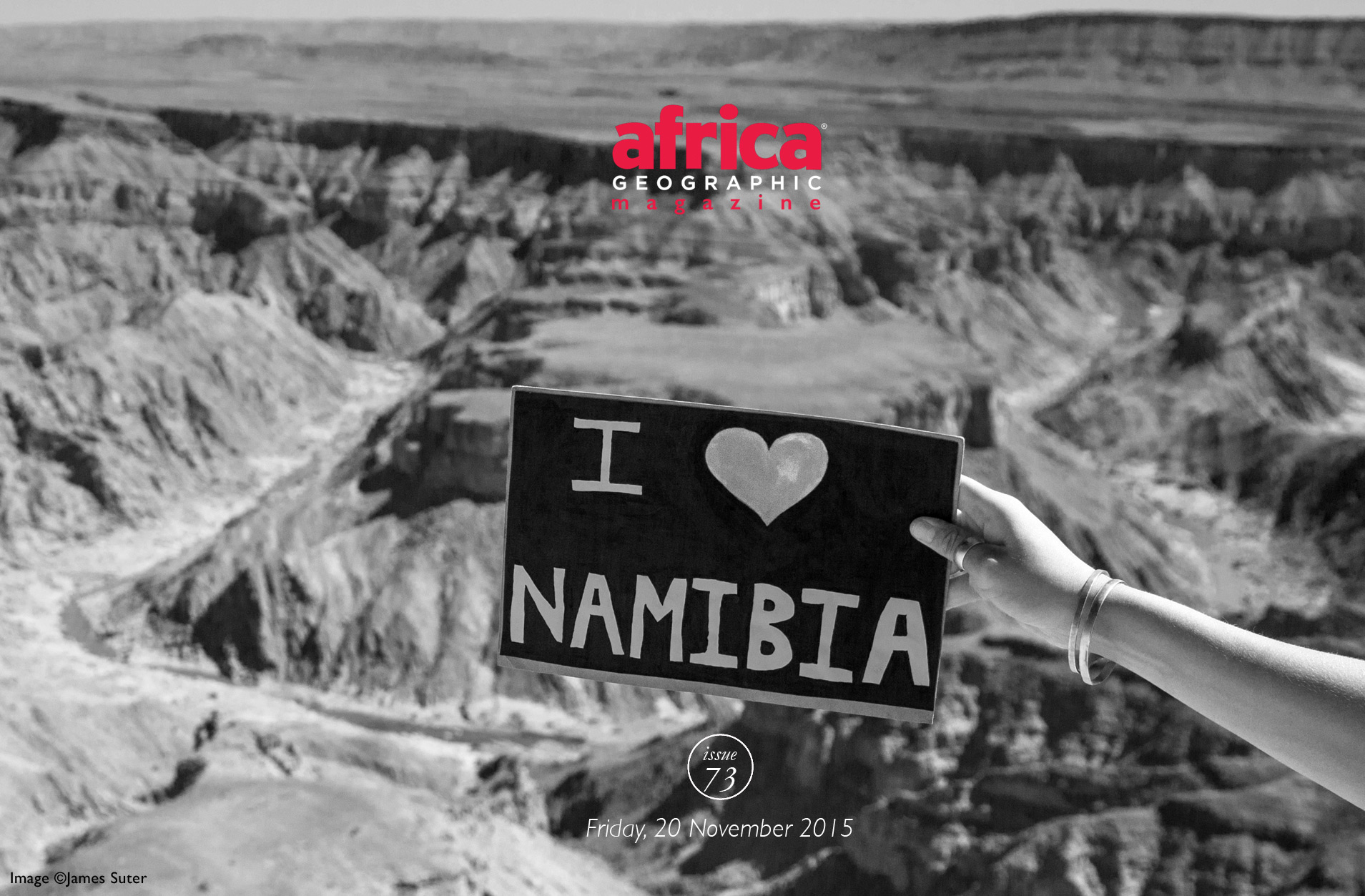
A six-week honeymoon exploring the wild places of Namibia.

At the start of September, we left our home in Cape Town to embark on a six-week road trip to celebrate our recent nuptials. Exploring the wild places of Namibia made for a different kind of honeymoon, and our road trip turned out to be a journey of a lifetime.
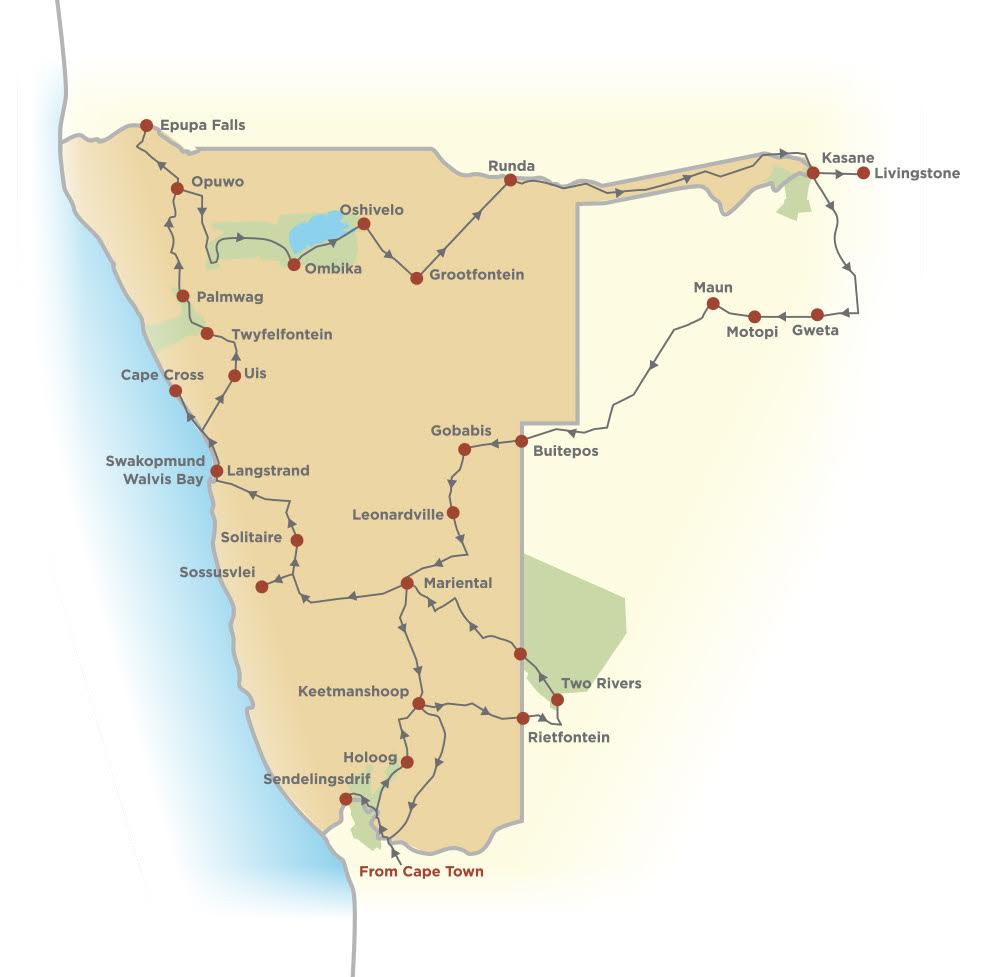
Criss-crossing borders
It made sense to break up the seven-hour drive to the Namibian border by first stopping at Namaqualand National Park in South Africa, where the flowers were in spectacular bloom. After a night of camping amidst a tapestry of brilliant colours, we continued on our way until we reached Sendelingsdrif on the Orange River in |Ai-|Ais/Richtersveld Transfrontier National Park. This meant crossing into Namibia only to cross back into South Africa for the night, but it was all relatively easy. This border park is the only real mountain desert in southern Africa, and the Richtersveld’s Martian landscape left a lasting impression on us. In this arid area, only the hardiest of life forms survive. However, despite this, the Richtersveld is regarded as the only Arid Biodiversity Hotspot on Earth, with a surprising variety of plant, bird and animal life; much of which is endemic.
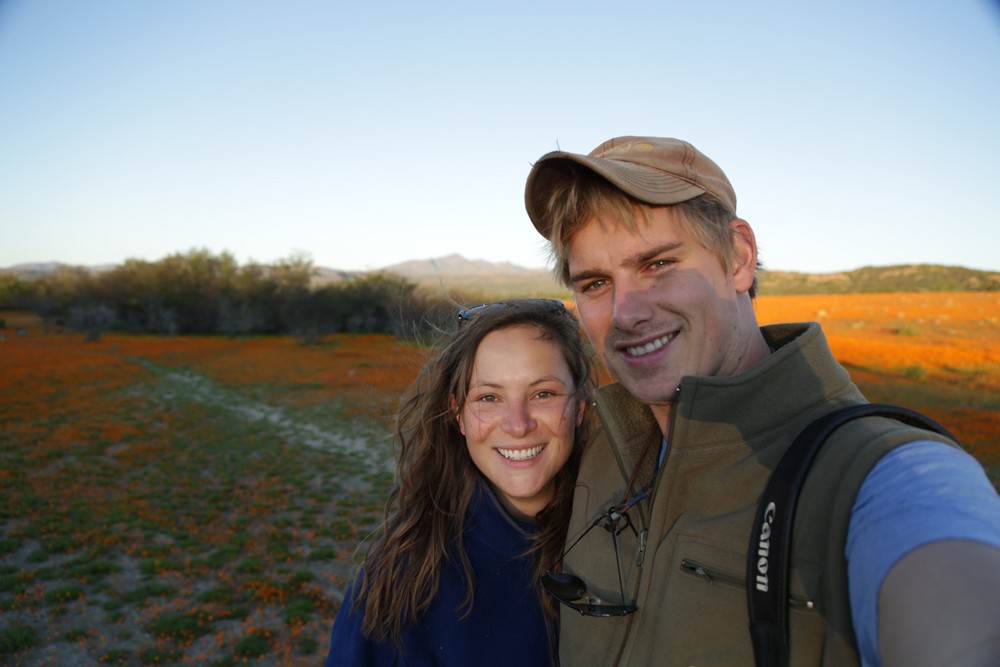
We travelled back into Namibia the following day and drove to Fish River Canyon. This is the second-largest canyon in the world after the Grand Canyon, and it was well worth the visit. We hadn’t planned it, but we even managed to make it to the quiver tree forest just outside Keetmanshoop by sunset and spent our evening with dassies, meerkats, a warthog and a border collie. Quiver tree forests are rare, and all three subspecies of the strange but beautiful trees that appear in the forest also, unfortunately, appear on the IUCN Red List of Threatened Species.
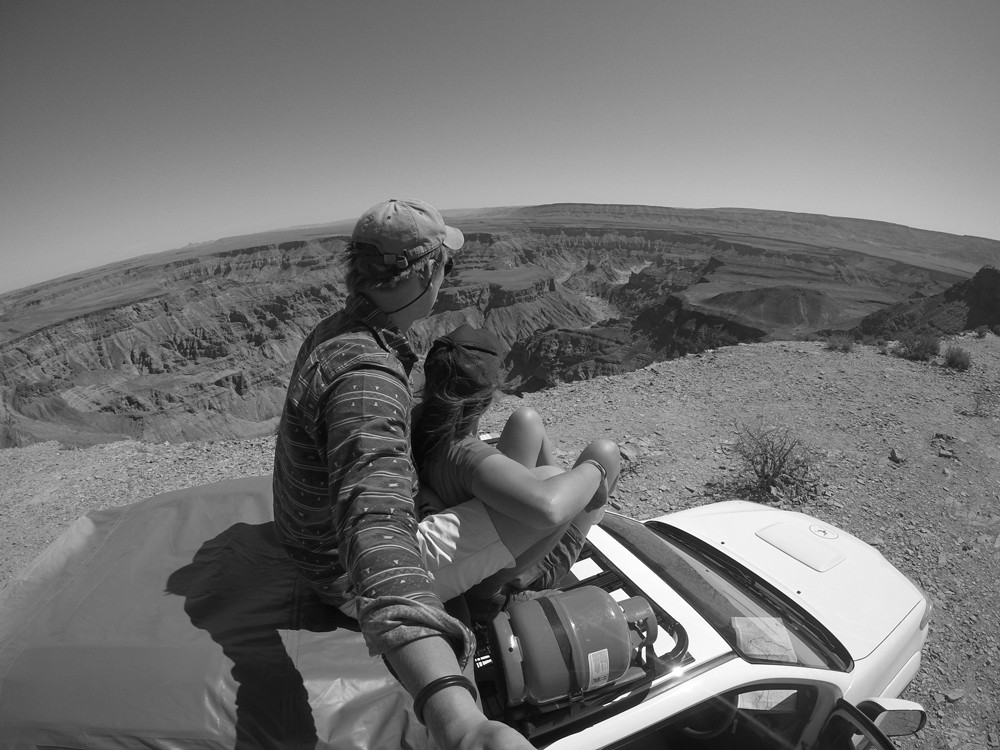
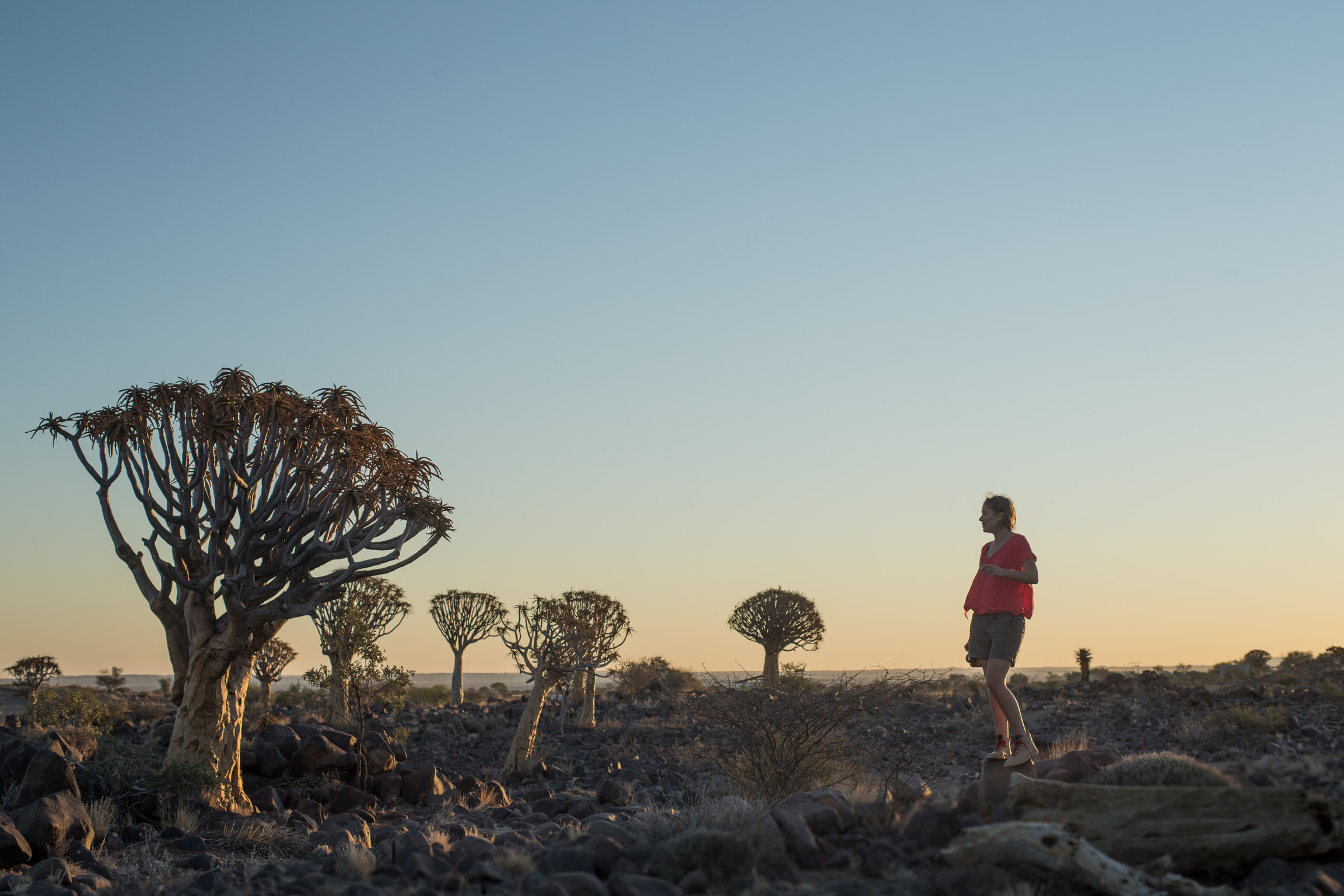
Exploring Namibia’s vast landscapes is a treat as the country is one of the ten least densely populated places in the world, and it often felt like we had it all to ourselves. The next day, we returned to South Africa to enter the Kgalagadi. The Kgalagadi has an abundance of varied wildlife, and it is home to large predators such as the iconic black-maned Kalahari lions, cheetahs, leopards and hyenas. Although the park was full, it didn’t feel overcrowded and once we drove some distance from the rest camp each morning, we were often on our own.
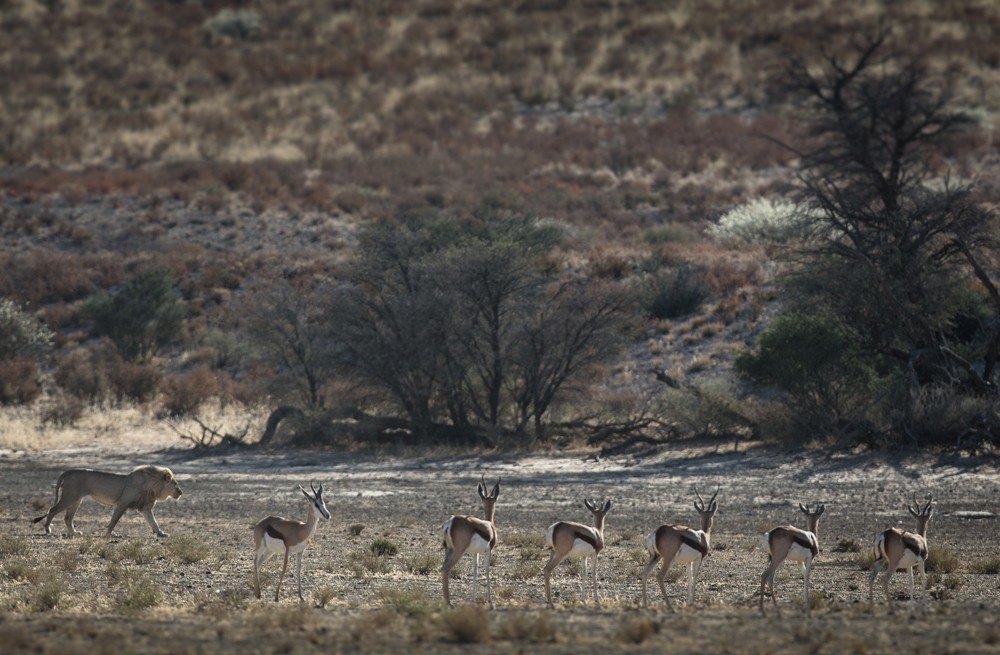


Exploring the Namib and its surrounds
Continuing our journey after we’d had our fill of predators, we thoroughly enjoyed the drive to Sossusvlei from the Kgalagadi via Mariental. The ambience created by goats, cattle and windmills along the dusty, open roads made it particularly magical.

We stayed at Desert Quiver Camp just outside the Sesriem Gate, the entrance to the Sossusvlei area of the Namib-Naukluft National Park. Sossusvlei is one of the most photographed places in Sub-Saharan Africa, and it is easy to see why. The enormous red dunes, so perfectly sculpted against the backdrop of the dazzling Namibian sky, are something to behold. Even experiencing a full-blown dust storm turned out to be quite spectacular.
These pristine mountains of sand have been shaped over millions of years by the colliding easterly winds from the Atlantic Ocean and the westerly winds from the Naukluft Mountains. We also spent a couple of hours alone exploring Deadvlei, and it was during this time that we encountered a solitary oryx. This iconic antelope was more relaxed than we would have expected, and we walked with him for some time while accompanied by the distinct sound of the Namibian sunset – the soft, rhythmic knocking of the toktokkie beetle.

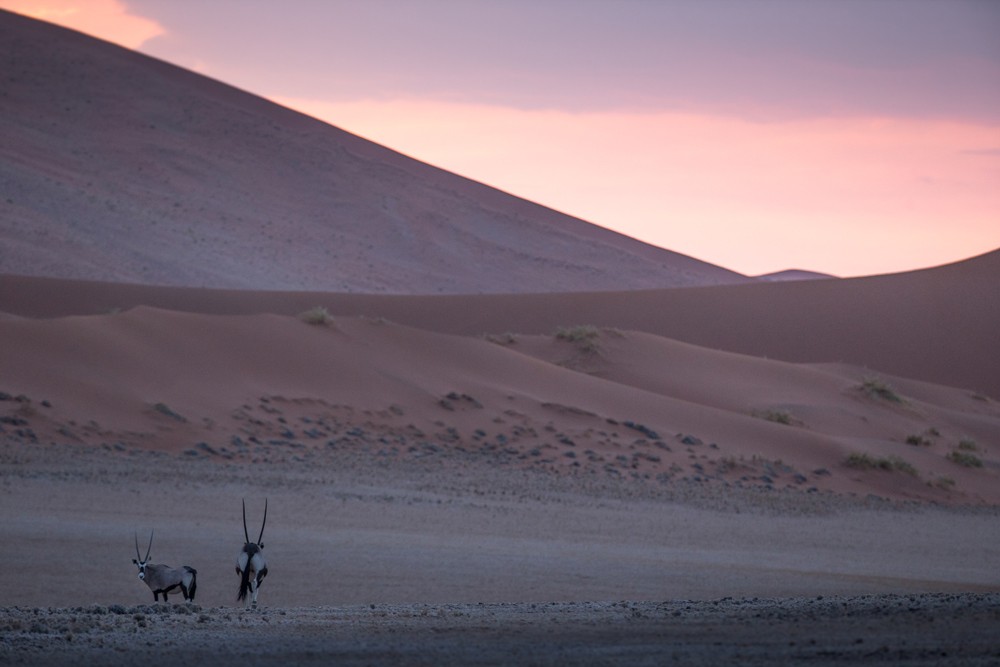
Heading north-west the next day, with the toktokkie’s morse code still ringing in our ears, the relatively short drive from Sossusvlei to Swakopmund was beautiful, and the terrain became increasingly more mountainous with spectacular strata. We were excited to arrive in Swakopmund, a beach town with German colonial architecture situated in the Namib Desert on the country’s wild coastline. We had our first meal at The Tug restaurant, which is stylishly built around the original Danie Hugo tugboat next to the jetty on the beachfront, and we checked in at the quaint Secret Garden Guesthouse, which is an excellent home-away-from-home that has the bonus of being within walking distance of the town. There is so much to do and see in Swakopmund, from sunset walks and dinners on the beachfront to spotting jackass penguins, sea lions and Cape fur seals on a boat cruise with Ocean Adventures in Walvis Bay.

Ancient rock art and desert-adapted wildlife
Once our bellies were full of German food, we left Swakopmund and drove up the Skeleton Coast, which is inundated with fog for most of the year as a result of the cold Benguela upwelling – a process in which deep, cold water rises to the surface and cools the overlying air. We spent time at Cape Cross and relished this fisherman’s paradise and the temperature change – this was the only time we wore beanies in Namibia. Then, we journeyed out of the fog to defrost in Twyfelfontein, passing through the small town of Uis on the way.
Twyfelfontein in the Kunene Region of north-western Namibia is famous for its ancient rock art, and this UNESCO World Heritage site is one of the many great reasons to visit the country. Ancient rock engravings and paintings can be found around a site inhabited 6,000 years ago – first by hunter-gatherers and later by Khoikhoi herders. At least 2,500 rock carvings and a few rock paintings can be admired. These engravings were the social media of yesteryear, and it was amazing to see the magic and mystery of these artworks.
North-western Namibia has been called an arid Eden, and people share their land and resources with desert-adapted elephant, black rhino, lion, giraffe, springbok, gemsbok, zebra and other wildlife. For this reason, it was hard not to prioritise on our trip, and we even had the chance to track rhino in a restricted area with Save the Rhino Trust Namibia. With poaching on the increase, we witnessed firsthand this small team’s challenge of patrolling an unfenced area larger than South Africa’s Kruger National Park.
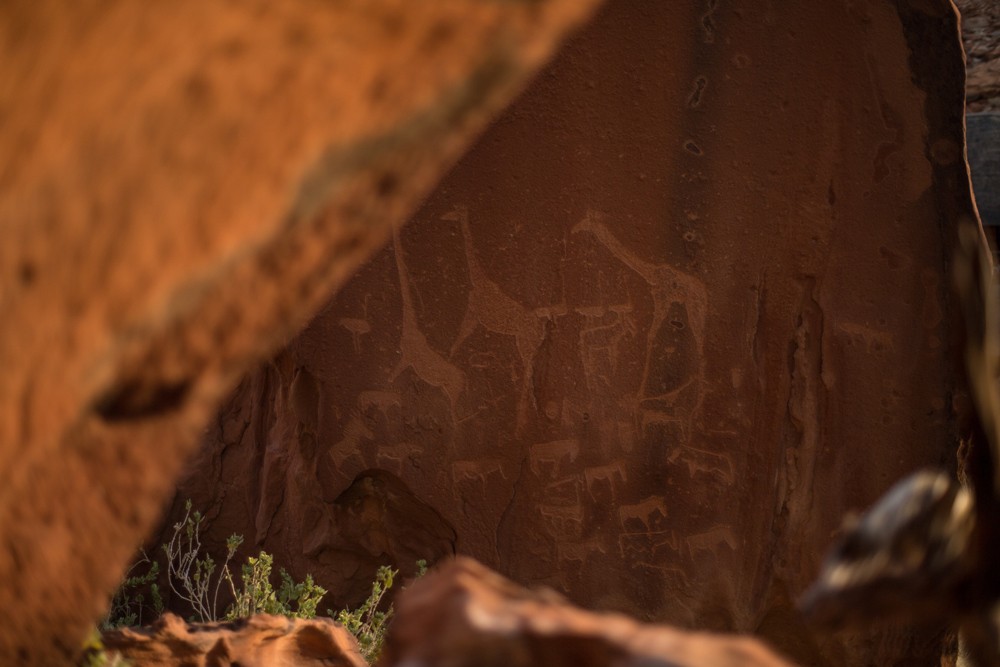
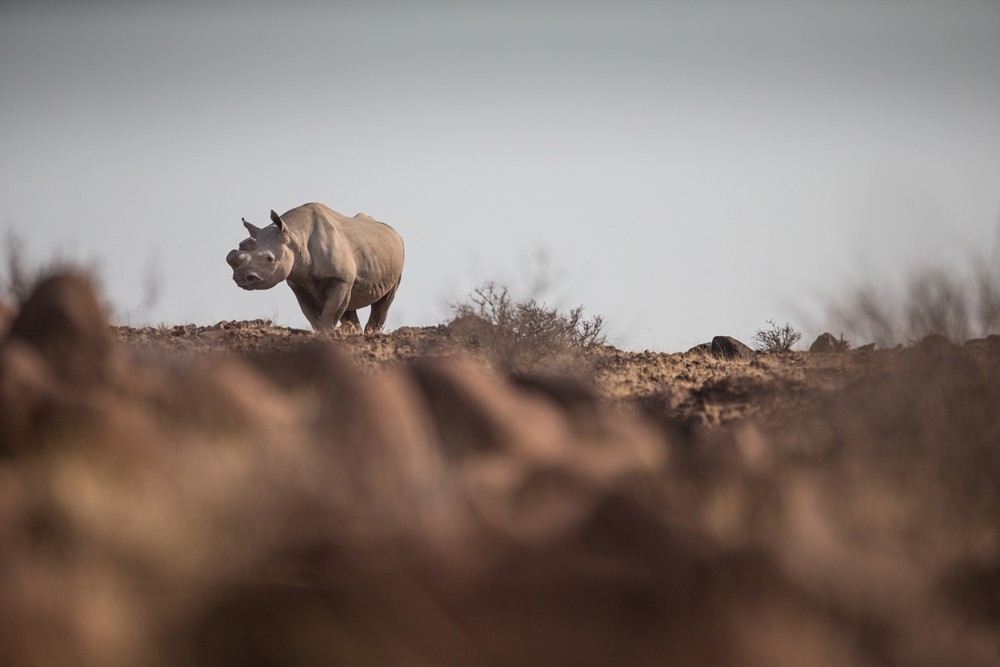
Reaching our oasis
After this rare opportunity, we ventured to Epupa Falls and northern Kunene. Epupa Falls is one of Namibia’s most picturesque destinations and a place we battled to leave. The falls lie within easy reach of the town of Opuwo, a bustling stop that boasts an eclectic mix of people, from tourists and business people to Himba men and women adorned in red ochre and hand-crafted jewellery. Axel Hartman, the chief operating officer at Save the Rhino Trust, had put us in touch with his friend, Koos Verwey, an ex-military man with a heart for the local people. We will never forget driving over the hill after kilometres of harsh, arid landscapes to see palm trees, baobab trees and other lush vegetation surrounding the falls and the beautiful Kunene River.

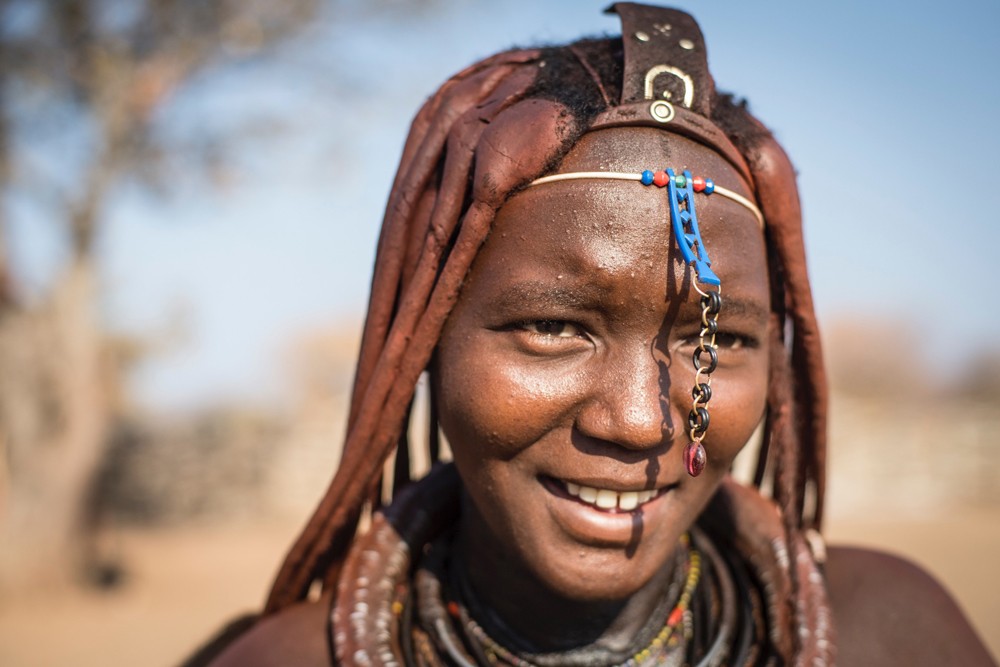
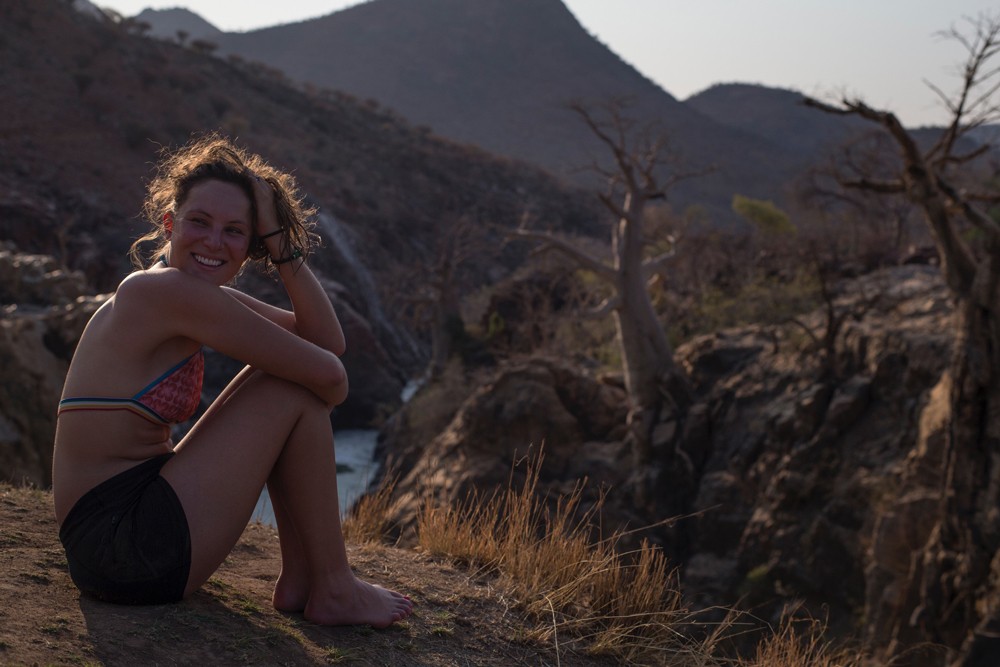
Waiting games at waterholes in Etosha
After three short days visiting local communities, making friends and learning about Koos’ work with the Himba tribe, we left Epupa Falls. We were soon immersed in Etosha National Park – a place we have always wanted to visit. We entered the formerly restricted western and wilder section of the park, which was only opened to the public in 2014, and we camped at the new Olifantsrus Camp right next to a waterhole teeming with wildlife. We then made our way across the park and spent two nights at Etosha Safari Lodge, which lies just 10km from the Anderson Gate near Okaukuejo. This was our first experience of the Gondwana Collection, and we can truly testify that there is something special about these lodges. After a fantastic two nights there, we indulged in another two at Mokuti Etosha Lodge, located just a four-minute drive from Etosha’s eastern Von Lindequist Gate near the historical Namutoni Fort.
Our muscles were soothed during a massage at Mokuti’s stunning spa that lies deep in the bush, away from the accommodation and other guests, and once rejuvenated, we spent the rest of our days waiting patiently at the waterholes. With it being so dry and so hot, the waterholes were alive with many different species that would visit them for a drink. In the short time that we stayed in the park, we sighted lion, hyena, black rhino, elephant, springbok, gemsbok, hartebeest, jackal, zebra, ostrich, honey badger, giraffe and wildebeest, as well as a variety of birds and smaller mammals like African wildcat and mongoose.
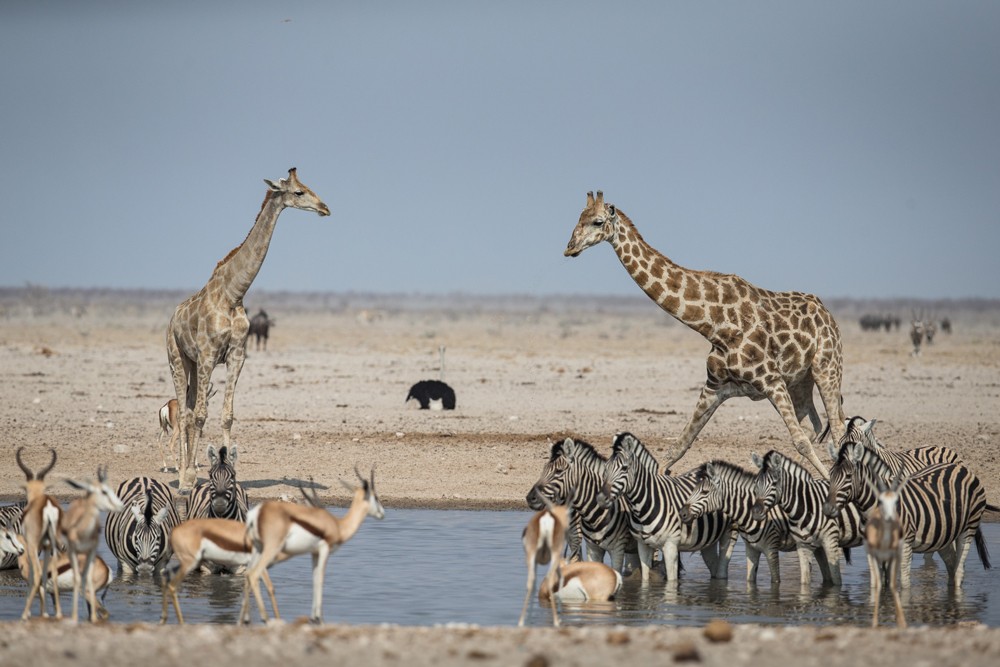
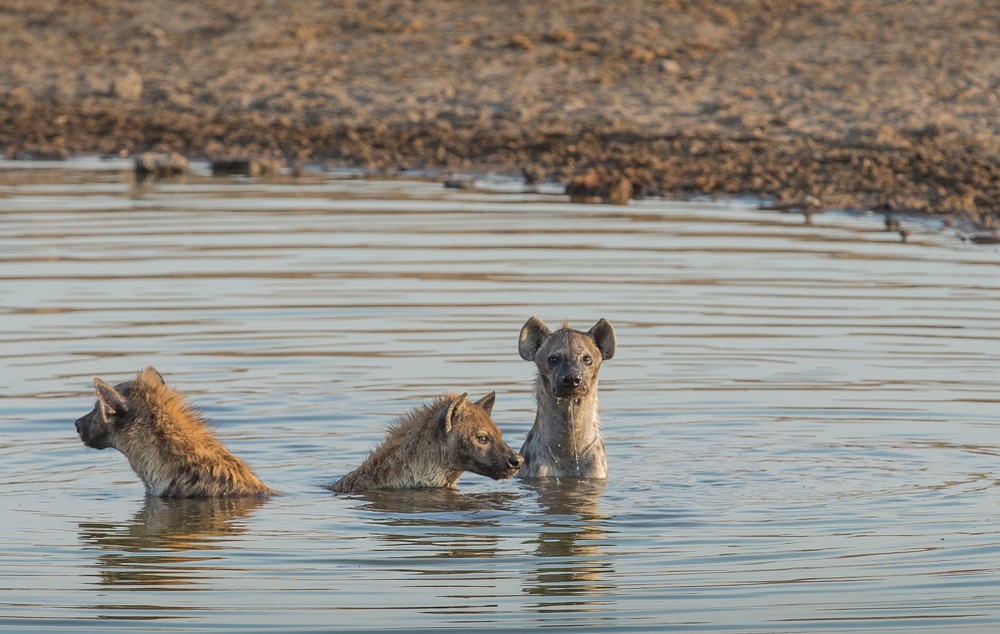
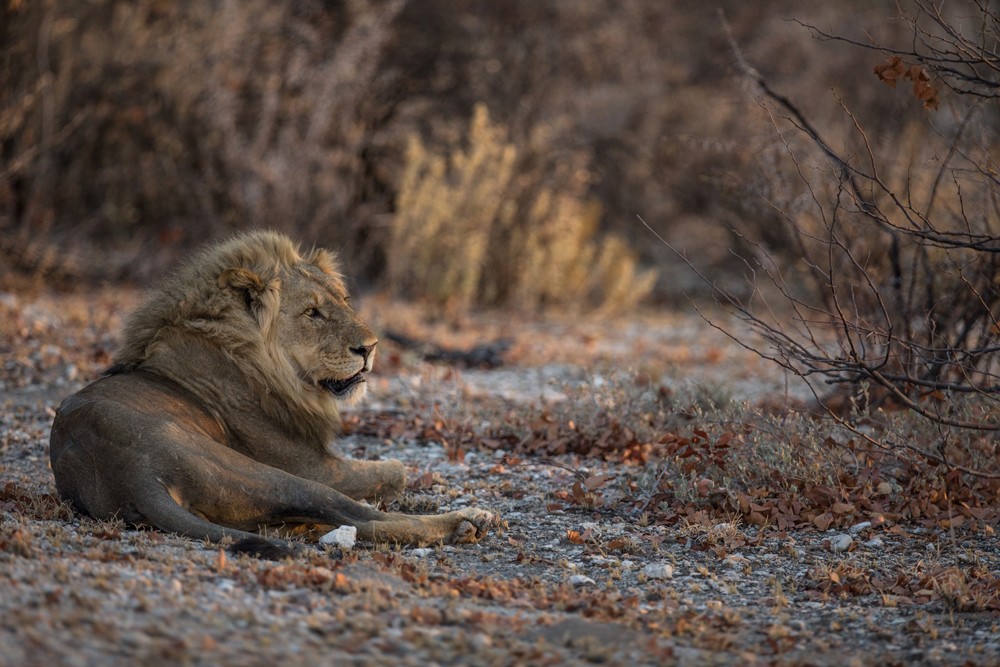
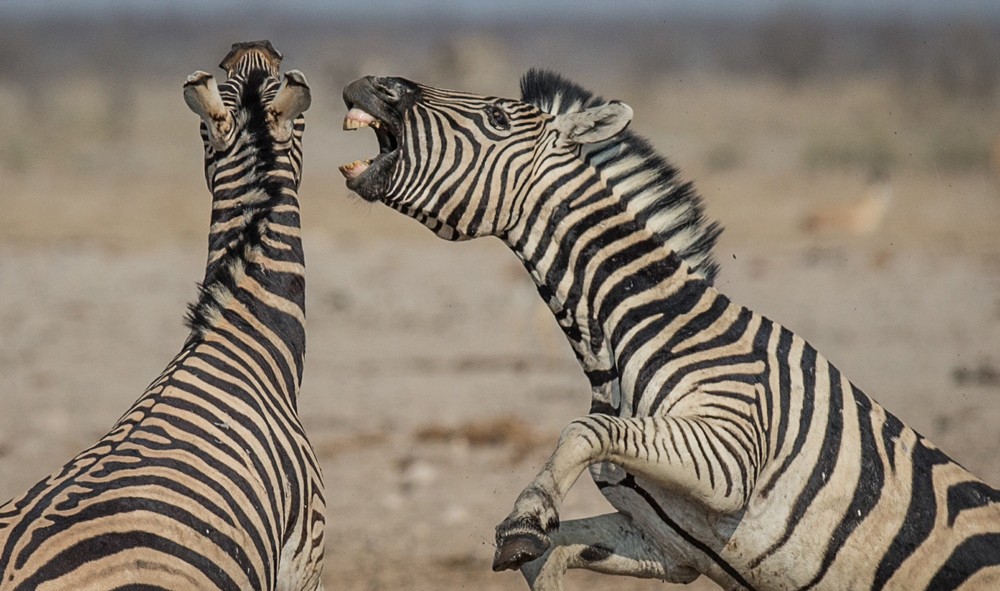
The Caprivi Strip – where four rivers meet
In contrast to the rest of the country, the Caprivi Strip, bordered by the Okavango, Kwando, Chobe and Zambezi rivers, is an area of fertile floodplains surrounded by perennial rivers.
The lush countryside appears out of nowhere after the desert landscapes of the south. Suddenly, we passed villages with goats, cattle and people by the roadside. We stayed at Hakusembe and Namushasha lodges, both part of the Gondwana Collection, and we enjoyed stunning boat cruises surrounded by lush vegetation and incredible birdlife.
Return to Cape Town
As soon as we left Namibia to enter Botswana and start our long journey home, we were welcomed by a herd of elephant crossing the tarred road just after the border post. We stayed at Chobe Marina Lodge and enjoyed cruises on the Chobe River before heading to Africa Albida’s Victoria Falls Safari Club, where we loved the vibe and energy of the lodge and the area. We had impeccable service while at the Safari Club, and we highly recommend their restaurant, The Boma.
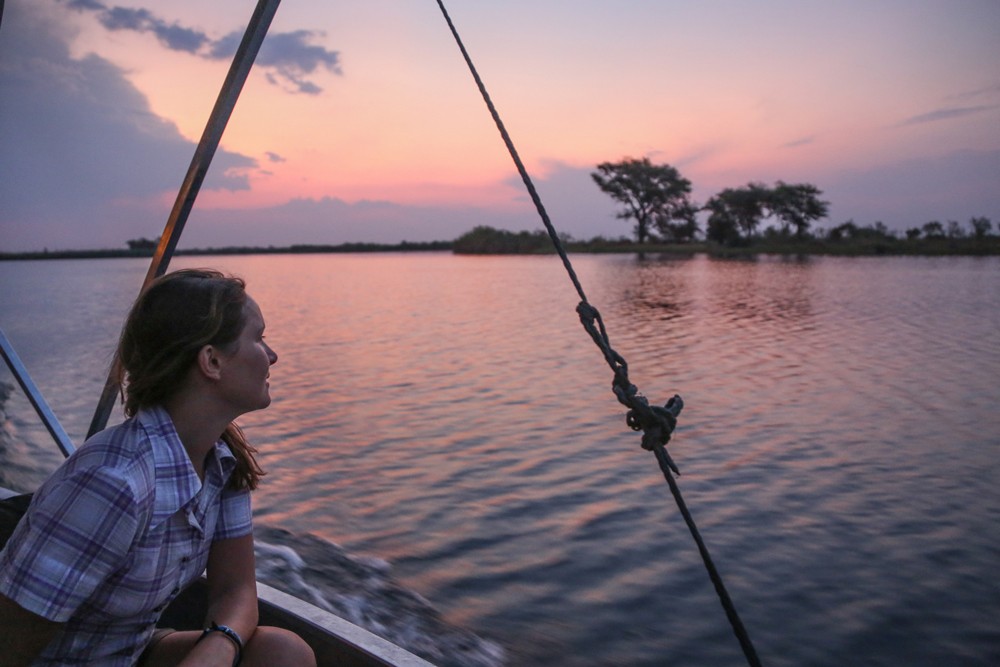
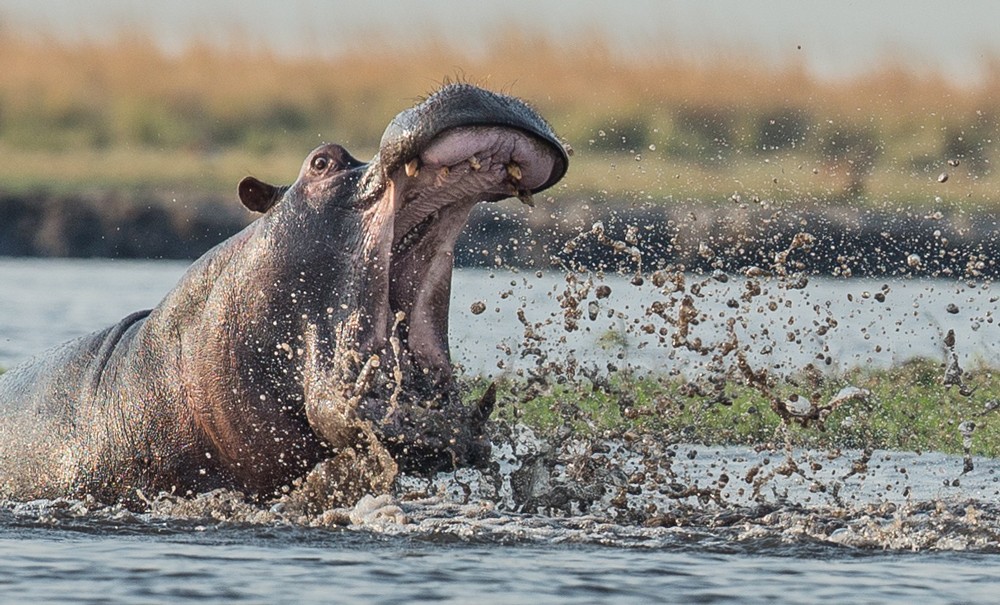
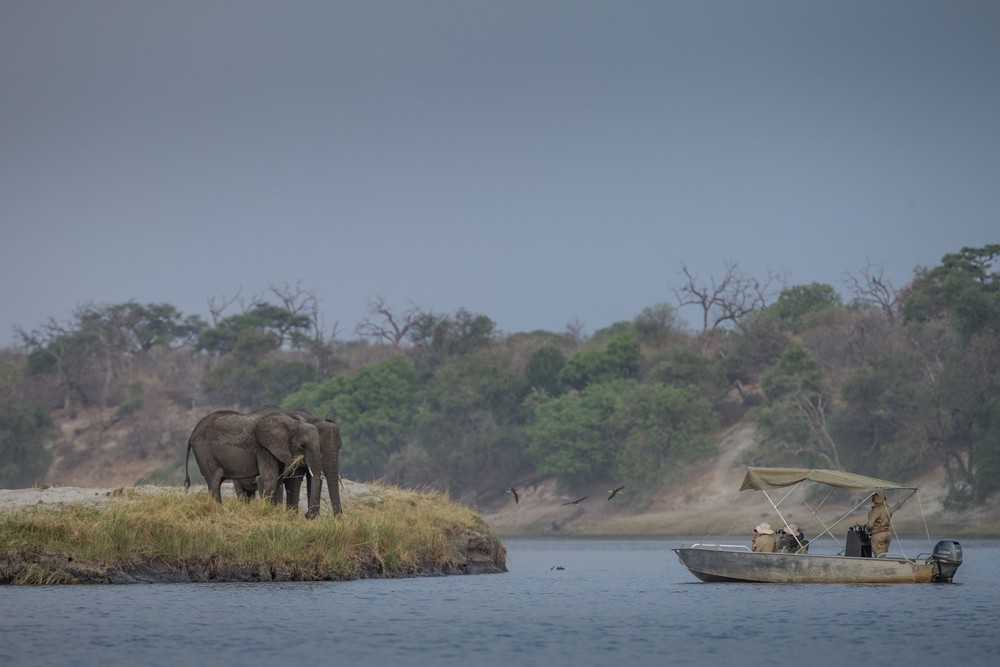
The most memorable part of our stay at Victoria Falls was white water rafting down the mighty Zambezi River. This was a little more extreme than we had anticipated – we got some serious exercise from paddling 27km down the river through rapids and climbing the steep winding path afterwards to catch our ride home.
We had now reached the most northern point of our travels, and it was time to turn back and head home. On the way back down, we stopped for a night at Planet Baobab near the Makgadikgadi Salt Pans in the middle of the dry savanna of north-eastern Botswana. It is one of the largest salt flats in the world, and the pan is all that remains of the enormous Lake Makgadikgadi, which once covered an area larger than Switzerland but which dried up several thousand years ago.
We also stopped at the Kalahari Farmhouse in central Namibia en route home – where we loved our stone cottage and reading on the lawn. We hopped on a game drive into the Central Kalahari from their neighbouring lodge before having our last sundowner with our feet in the red dunes overlooking the desert.
Where to stay
For accommodation options at the best prices, visit our collection of camps and lodges.
From campsites to luxury lodges, there’s something for everyone in Namibia. If you’re thinking of planning a trip, here’s a shortlist of some of the places where Sam and James stayed on their travels that they highly recommend:
Twee Rivieren Rest Camp is run by SANParks and is the Kgalagadi Transfrontier Park’s largest camp. It is the only camp in the park with round-the-clock electricity and cell phone reception, so if you’re tired after a long day’s travelling, this is the best place to re-charge your batteries.
The Secret Garden Guesthouse is in the heart of ‘Old Swakopmund’ and offers a home for pizza-loving families and pets. Reasonably priced, it is an excellent base from which to explore all the adventure that the town has to offer.
Situated 120km north of Swakopmund, Cape Cross Lodge lies just metres from the Atlantic Ocean, providing a perfect place to explore the untamed wilderness of the Skeleton Coast.
Are you looking for the best seat in the house to view the falls? Then head to Epupa Falls Lodge, owned by ex-military man Koos Verwey and found in the heart of Kaokoland – home to the ancient Himba people who are indigenous to Namibia.
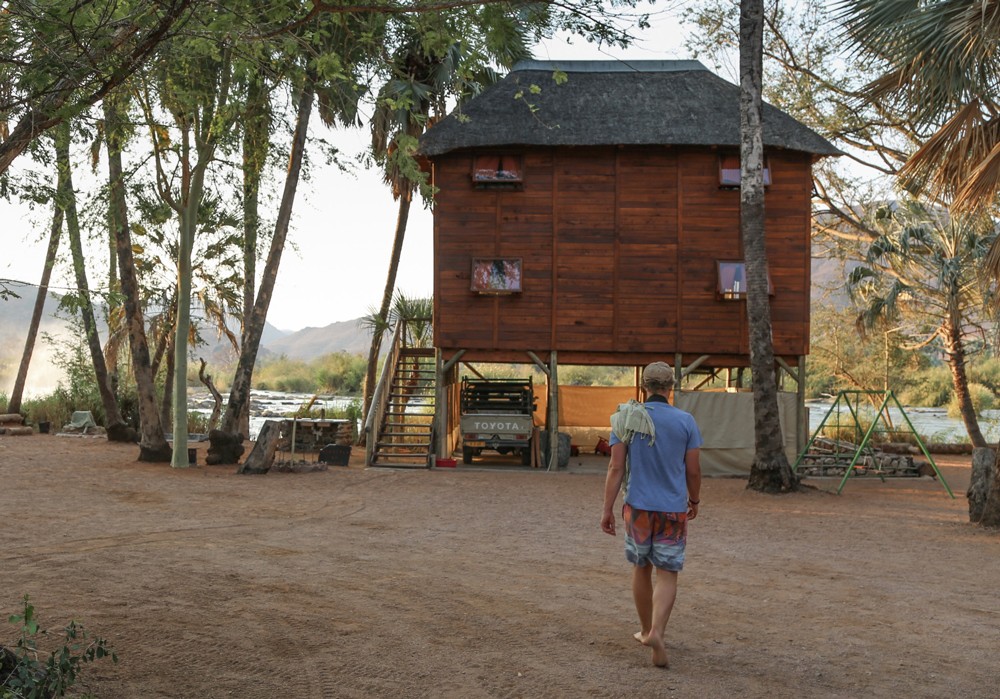
Twyfelfontein Country Lodge is a luxurious lodge located in the Kunene region of Namibia, which prides itself on various rock engravings and paintings that date back to the first hunter-gatherers in the area.
Mokuti Etosha Lodge is the perfect place for travellers who wish to explore the diverse wildlife in the famous eastern side of Etosha National Park. Mokuti prides itself on modern accommodation in a landscaped setting, with views of beautiful gardens and the indigenous bush beyond.
Hakusembe River Lodge and Namushasha River Lodge on the Caprivi strip both provide incredible idylls for the most seasoned of travellers, and you can unwind away from the world once you’ve stepped into the magical enclave of the Kalahari Farmhouse.
 Search our ready-made safaris or ask us to build one just for you.
Search our ready-made safaris or ask us to build one just for you.
Where to eat
Stop off for an apple crumble at Solitaire Moose Macgregor Bakery at Solitaire Country Lodge en route to Swakopmund from Sossusvlei. Life’s short; eat dessert first.
Tuck into a richly diverse menu at The Tug in Swakopmund and pair your meal with one of 140 of the finest South African wines on offer. Or if you have more of a craving for bratwurst and sauerkraut, don’t miss the Swakopmund Brauhaus for the chance to dine in a typically Bavarian setting in Africa.
With three restaurants, as well as a microbrewery, beer garden, deli and a beach kiosk with its private pavilion, the Strand Hotel Swakopmund has it all. Its sea-facing terraces make it the perfect place to enjoy Namibian oysters and a great view.
Don’t drive past The Fish Deli in Swakopmund without stopping for a delicious smoked salmon and egg roll.
Tips and tricks
1. When going on a game drive in the Kgalagadi, get out as early as possible so you don’t have to endure the dust from other vehicles.
2. Book well in advance for a trip, especially if you wish to travel in September.
3. Spend quality time at waterholes in Etosha, and your patience will pay off.
4. Many people find Deadvlei more impressive and less busy than Sossusvlei.
5. Beat the crowds and enjoy the sunrise by climbing the dunes in the morning.
6. Drink lots of water to avoid heatstroke, but first, ensure it is drinkable.
7. Don’t swim in the Kunene River at Epupa Falls, as there are crocodiles. Rather cool off in the pools at the top of the waterfall – after checking which ones are safe.
8. Support a community campsite. You are almost camping in the community’s backyard, contributing to conservation by supporting these sites.
9. Know your vehicle. Although help can be found along some routes, be prepared to change a tyre (or three).
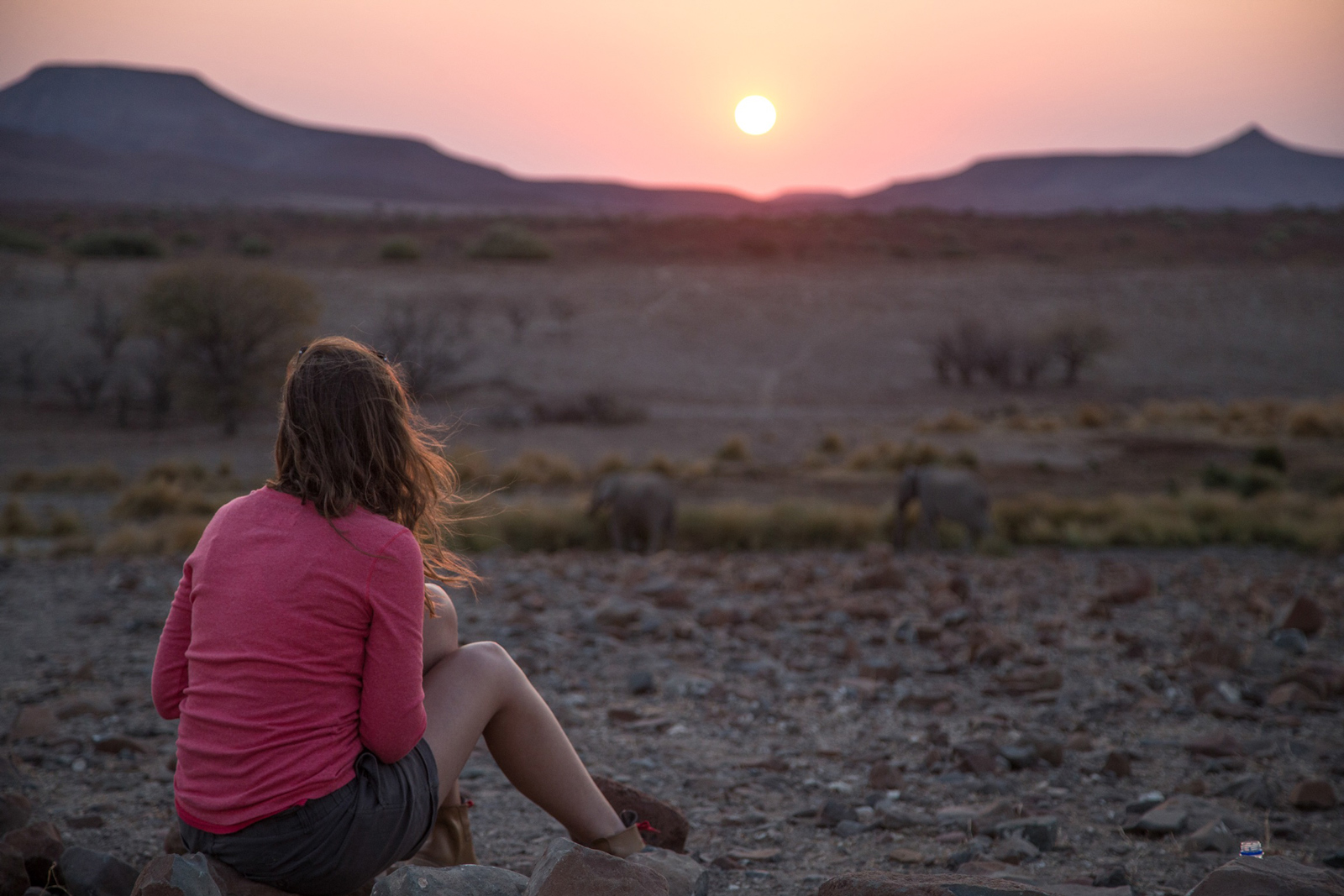
About the authors
 James and Sam Suter were exposed to the wonders of Africa and its wilderness areas from a young age. After graduating with a diploma in Environmental Studies, James went on to guide where he honed his skills, picked up his camera and started documenting the scenes from his day-to-day life. James now offers private photographic safaris and operates throughout Southern and East Africa. As well as his private guiding, James is co-owner of Black Bean Productions – a small, independent production company in Cape Town. Sam is the producer at Black Bean Productions. With a passion for conservation, travel and Africa, she creates short films and assists teams in raising much-needed funds and awareness to continue the good work that they are doing on the ground.
James and Sam Suter were exposed to the wonders of Africa and its wilderness areas from a young age. After graduating with a diploma in Environmental Studies, James went on to guide where he honed his skills, picked up his camera and started documenting the scenes from his day-to-day life. James now offers private photographic safaris and operates throughout Southern and East Africa. As well as his private guiding, James is co-owner of Black Bean Productions – a small, independent production company in Cape Town. Sam is the producer at Black Bean Productions. With a passion for conservation, travel and Africa, she creates short films and assists teams in raising much-needed funds and awareness to continue the good work that they are doing on the ground.
To comment on this story: Login (or sign up) to our app here - it's a troll-free safe place 🙂.![]()






